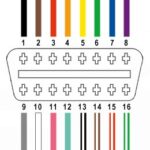For car enthusiasts and everyday drivers alike, understanding your vehicle’s health is becoming increasingly important. Enter the ELM327 WiFi wireless OBD2 scanner, a tool that promises to put professional-level diagnostics into your hands without breaking the bank. But does it live up to the hype? This review takes an in-depth look at the ELM327 WiFi wireless OBD2 scanner, exploring its features, capabilities, and whether it’s the right choice for your automotive diagnostic needs.
The ELM327 chip has become a popular foundation for affordable OBD2 (On-Board Diagnostics II) scanners. These compact devices plug into your car’s OBD2 port – typically located under the dashboard – and communicate wirelessly with your smartphone, tablet, or laptop via WiFi. This wireless capability offers convenience and flexibility compared to older, wired scanners. The promise of accessing real-time engine data, reading and clearing trouble codes, and monitoring vehicle performance from your own device is undeniably appealing.
One of the primary advantages of the ELM327 WiFi wireless OBD2 scanner is its affordability. Compared to professional diagnostic tools that can cost hundreds or even thousands of dollars, ELM327 scanners are available for a fraction of the price. This low entry point makes car diagnostics accessible to a wider audience, from DIY mechanics to car owners simply wanting to understand their vehicle better and potentially save on repair costs.
Functionality-wise, these scanners, when paired with the right software, can perform a range of diagnostic tasks. At the most basic level, they allow you to read diagnostic trouble codes (DTCs) that trigger your check engine light. Understanding these codes is the first step in diagnosing car problems. Furthermore, they enable you to clear these codes, which can be useful after completing a repair. Beyond basic code reading and clearing, many ELM327-compatible software applications offer real-time sensor data monitoring. This means you can observe parameters like engine temperature, RPM, oxygen sensor readings, and much more, as you drive. This live data stream can be invaluable for troubleshooting performance issues and understanding how different systems in your car are operating.
To fully utilize the ELM327 WiFi wireless OBD2 scanner, software is essential. The market offers a variety of compatible applications, each with its own set of features and user interface. Bundled with many ELM327 scanners, you might find basic software like ScanTool.net for Windows v1.13. As noted in initial explorations, ScanTool.net provides fundamental functionalities – code reading, code clearing, and basic sensor data display.
However, for users seeking more advanced capabilities, software like TouchScan (ScanTool.net LLC – TouchScan OBD Software – ScanTool.net) stands out as a more comprehensive option. TouchScan, even in its demo version, showcases a wider array of features. Beyond the standard code reading and clearing, it offers real-time stats, freeze frame data (snapshots of sensor readings when a trouble code is triggered), and detailed vehicle information.
Setting up TouchScan with an ELM327 WiFi wireless OBD2 scanner is generally straightforward. The “AutoDetect” feature simplifies the connection process by automatically scanning COM ports and identifying the scanner. It then cycles through baud rates and protocols to establish communication with your vehicle’s ECU (Engine Control Unit). Once connected, TouchScan visually confirms the connection status, typically with indicators turning green.
Once connected, the customizable dashboard feature in TouchScan becomes a powerful tool. You can configure it to display gauges showing the parameters most relevant to you, providing a real-time view of your vehicle’s operation.
To test the diagnostic code reading capability, simulating a fault, such as unplugging the MAF (Mass Air Flow) sensor, can trigger a check engine light and store trouble codes in the ECU. Using TouchScan, you can then retrieve these codes, like P0102 and P0113 in a MAF sensor disconnection scenario, and understand the nature of the problem.
The Freeze Frame Data feature adds another layer of diagnostic depth. It captures a snapshot of vehicle parameters at the moment a trouble code is recorded. This information, including engine temperature, speed, and RPM, can provide valuable context for understanding the conditions under which a fault occurred.
Perhaps one of the most impressive features for in-depth analysis is the recording function. TouchScan allows you to record a drive session, capturing all sensor data in real-time. This recorded data can then be played back, allowing you to review vehicle performance under various driving conditions as if you were still behind the wheel.
Beyond these core functionalities, TouchScan and similar software often provide access to a wealth of vehicle information screens, displaying various sensor readings and system statuses.
Pros of ELM327 WiFi Wireless OBD2 Scanners:
- Affordability: Significantly cheaper than professional scan tools.
- Wireless Convenience: WiFi connectivity offers freedom of movement and ease of use with smartphones, tablets, and laptops.
- Versatility: Compatible with a wide range of OBD2 compliant vehicles and software applications.
- Feature-Rich (with appropriate software): Can provide access to real-time data, code reading/clearing, freeze frame data, and more, depending on the software.
Cons of ELM327 WiFi Wireless OBD2 Scanners:
- Software Dependency: Functionality heavily relies on the quality and features of the software used. Basic software may offer limited capabilities.
- Potential Connectivity Issues: WiFi connections can sometimes be less reliable than wired connections.
- Not Professional Grade: While powerful for their price, they may not offer the advanced diagnostics or robustness of professional tools used by mechanics.
Conclusion:
The ELM327 WiFi wireless OBD2 scanner, when paired with capable software like TouchScan, presents a compelling and cost-effective solution for car diagnostics. It empowers car owners to understand their vehicle’s health, troubleshoot issues, and potentially save money on repairs. While it may not replace professional-grade tools for complex diagnostics, for DIY enthusiasts, hobbyists, and everyday drivers seeking to be more informed about their cars, the ELM327 WiFi wireless OBD2 scanner offers excellent value and functionality. For around $40 for the scanner and software, it’s a worthwhile investment for anyone wanting to delve into the world of automotive diagnostics.
